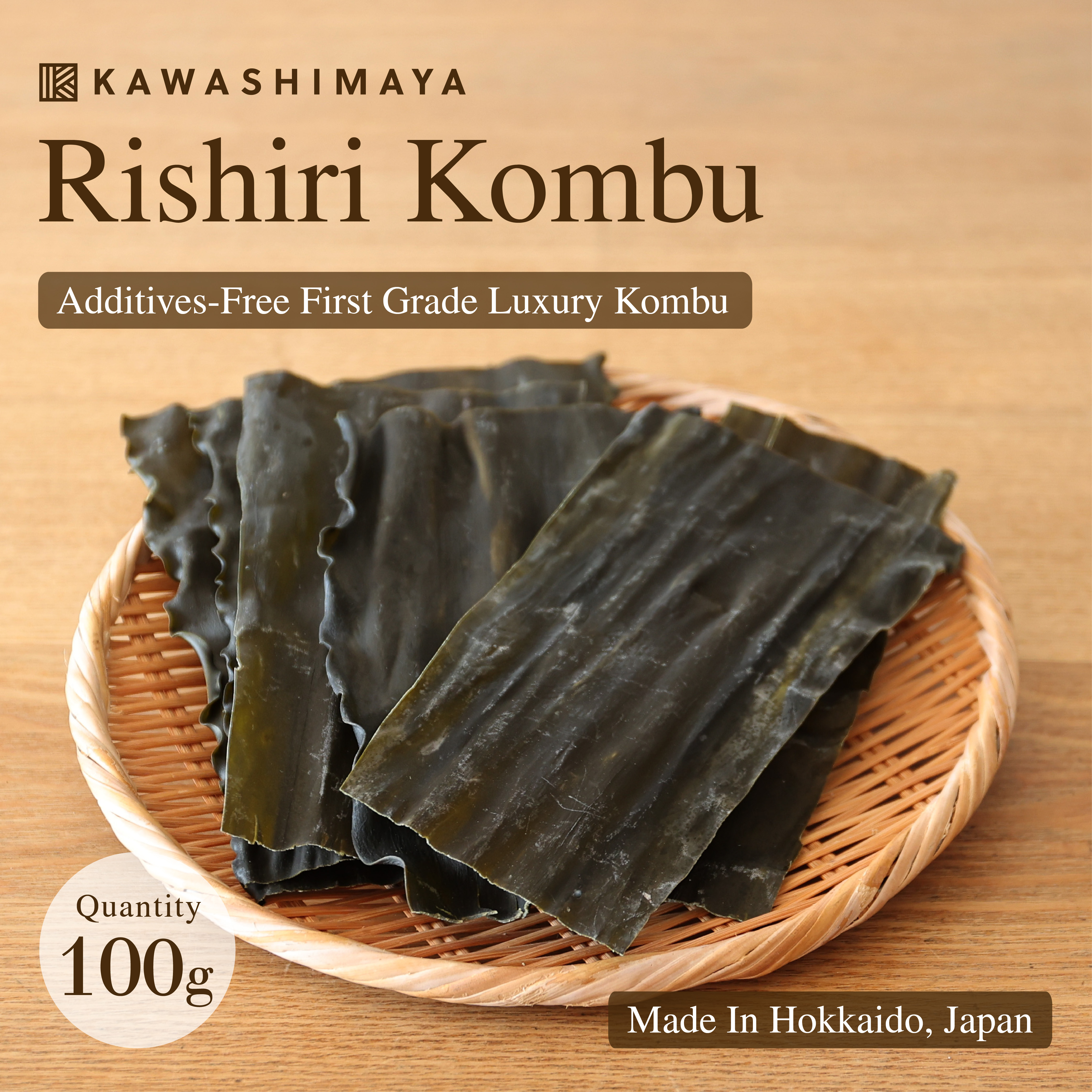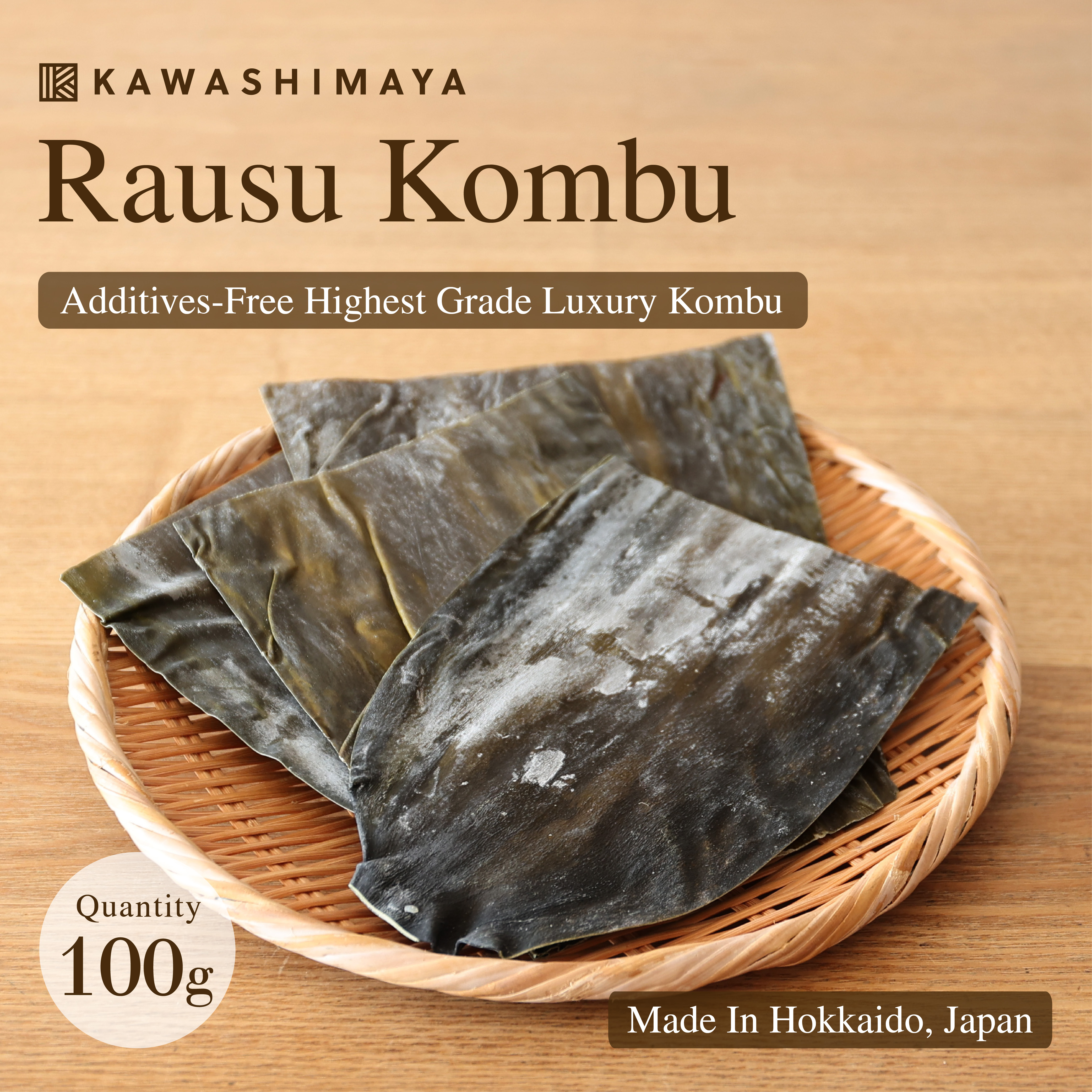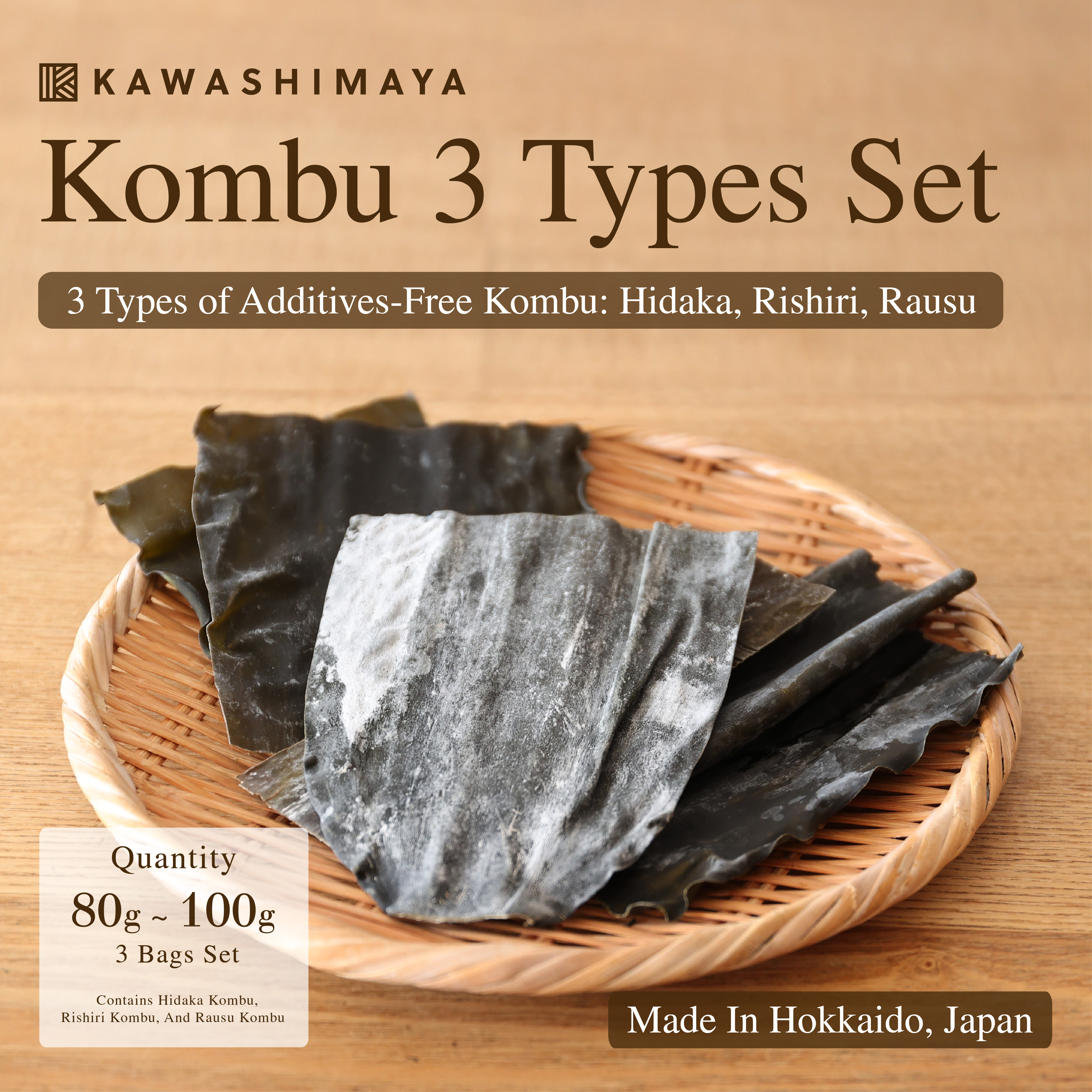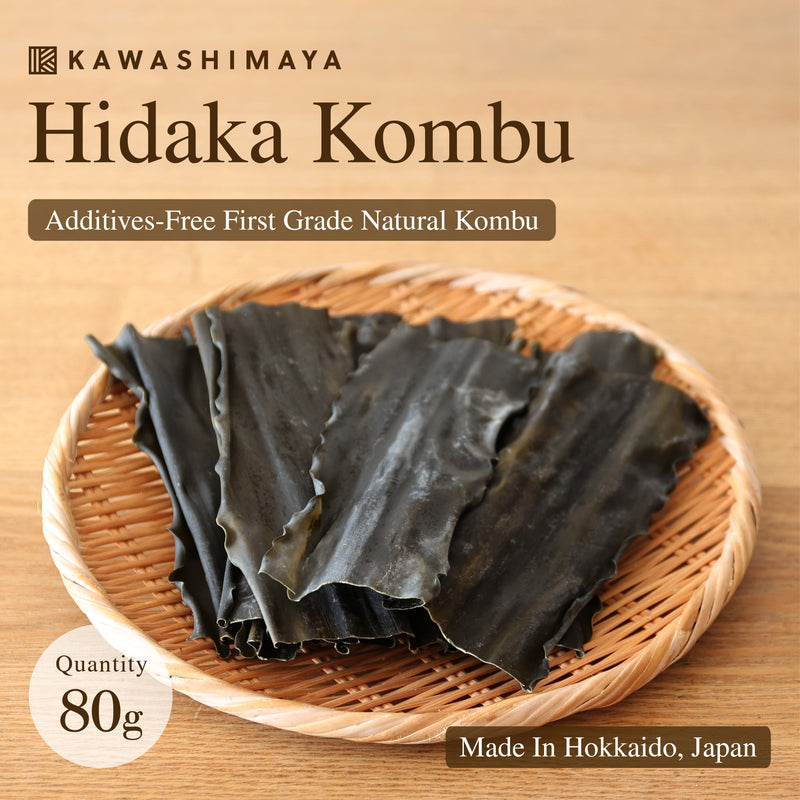
Hidaka Kombu Kelp From Hokkaido 80g - First Grade, Carefully Selected, Additive-Free Natural Kombu
Out Of Stock
Thick First Grade Natural Kombu Kelp, Grown By The Rough Seas
Hidaka kombu kelp from the Hidaka region in Southern Hokkaido has a unique flavor that is unique to kelp. Moreover, the soup stock derived from Hidaka kombu kelp is well-suited for various dishes.
From hot pot to soup, you can use this kombu kelp Because the kombu is thick and does not crumble easily, you can enjoy a nice bite and texture even when it is boiled.

Hidaka kombu is a kombu kelp that is popular with many people because of its reasonable price and reliable quality. It is also used as an ingredient in commercially available rice balls in Japan.
At Kawashimaya, we only handle high-quality first-class kombu kelp that meets the strict standards of thickness, color, and flavor, and accounts for only about 10% of the total domestic kombu production.
Recommended for New Year's kombu rolls
In addition to being soft and easy to boil, Hidaka kelp is also chewy and is perfect for kombu maki for Japanese New Year cooking.
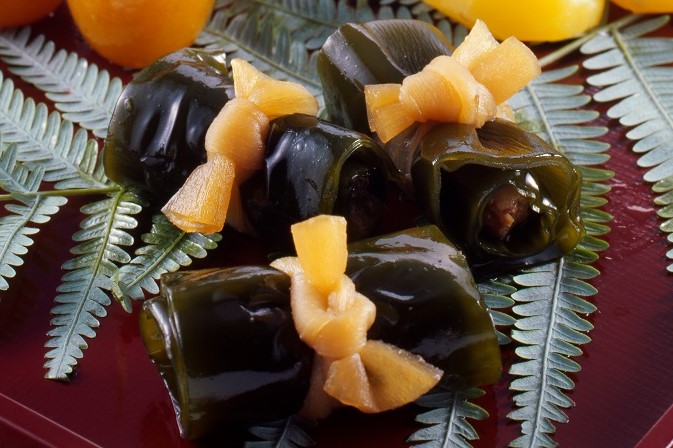
NOW AVAILABLE ON AMAZON USA!
We are pleased to inform you that this product is now available on Amazon USA. Click the link to see the product!
BUY ON AMAZONThe Difference Between Hidaka, Rishiri, And Rausu Kombu Kelp
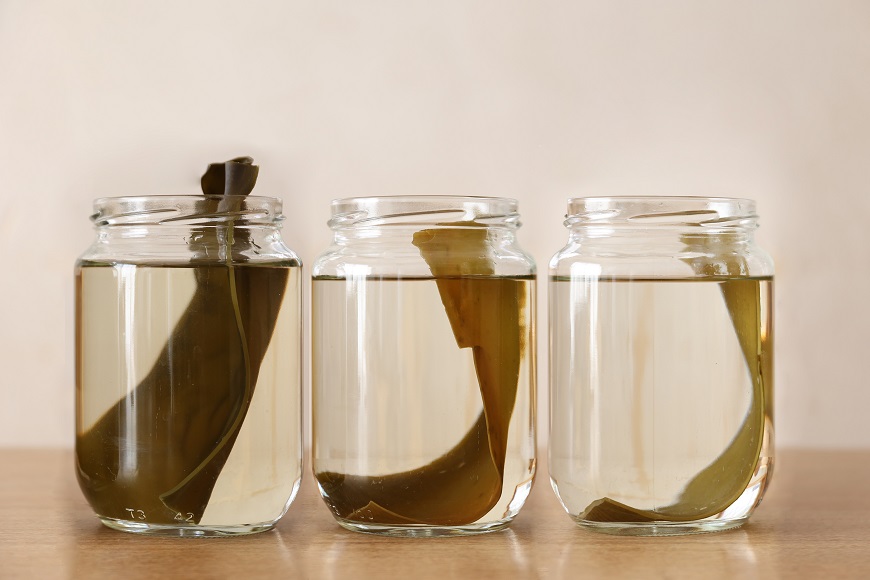
There are various types of kombu stock, which is the basis of Japanese food.
The three types of kombu kelp provided by Kawashimaya are Hidaka kombu (left), Rishiri kombu (middle), and Rausu kombu (right)
Hidaka
Can be found in: General everyday cooking. Can be found as a commercial onigiri filling
Characteristics:Mellow flavored, yellowish color
Umami Content (※): 1344mg/100g
Texture: Soft after boiled
Main Uses: Miso soup, simmered soup stock, oden ingredients, kombu rolls, etc.
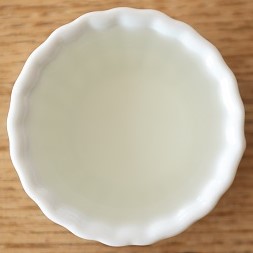
Rishiri
Can be found in: Restaurant cooking and vegetarian food.
Characteristics:Clear, no particular odd taste
Umami Content (※): 1985mg/100g
Texture: Hard
Main Uses: Suimono (clear soup), yudofu (boiled tofu), soup stock, kelp water
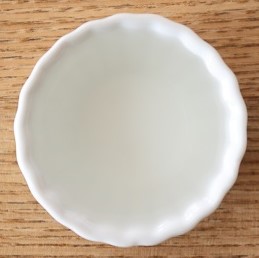
Rausu
Can be found in: Highest grade cooking, special occasions.
Characteristics:Very strong umami, prominent both in color and flavor.
Umami Content (※): 2286mg/100g
Texture: Easily dissolvable
Main Uses: Stock for hot pot, soup stock, salt ramen, kelp water, kobujime (a technique of preserving fish between kombu sheets)
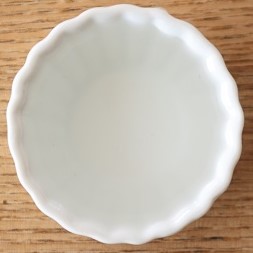
※NPO Umami Information Center
For Everyday Use: Kombu Based Stock Soup And Simmered Dishes
Hidaka kombu kelp is softer to boil when compared to other kelp and has a good texture. In addition to soup stock such as miso soup, kombu can be suitable as a base for various dishes such as oden, simmered ingredients, kombu roll, and tsukudani.
Use It To Make Kombu Based Stock (Kombu Dashi)
Hidaka kombu stock has a mellow taste and a refreshing aftertaste, so you can use it not only for kombu stock (kombu dashi) alone, but also for a combined stock with dried bonito flakes.
Miso Soup With Tofu And Wakame Seaweed
70g Silken Tofu
2-3g Dried Seaweed
300ml Kombu Stock (Kombu Dashi)
1.5 tbsp Miso
1. Put kombu dashi stock in a pan, heat it over medium heat until just before boiling, add dried wakame seaweed that has been rehydrated with water, then add silken tofu that has been cut into bite-sized pieces. Boil for 2 to 3 minutes.
2. Turn off the heat, dilute miso paste, mix it with the soup stock in the pot and stir thoroughly.
If you use kombu based stock, the natural taste of simple miso soup will be greatly enhanced. Miso soup made from nutritious kombu is also recommended for those who want to improve into a healthier lifestyle.
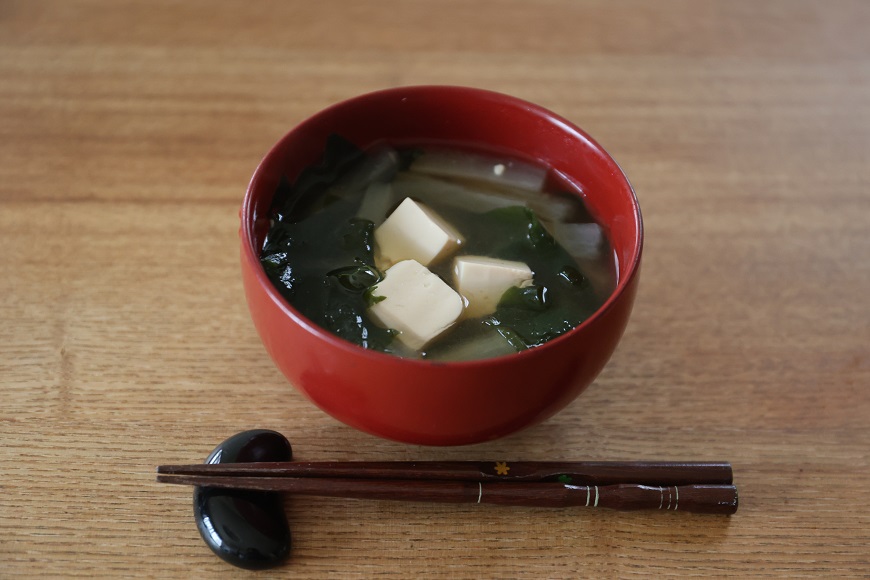
Use The Dried Kombu Kelp As It Is
Hidaka kombu can be the main character of a delicious dish just by soaking it in water.
Taking advantage of its softness that is not easily crumbled, you can use it as an ingredient for stir-fried foods with plenty of umami. Turn it into simmered foods such as oden or kombu maki rolls for the New Year.
Kombu Kinpira (Simmered Kombu Kelp)
2 Pcs Hidaka Kombu
200ml Water (to rehydrate the kombu sheets)
1 Red Pepper
1 tsp Sesame Oil
1 tbsp Soy Sauce
1 tbsp Mirin
Appropriate amount of ground sesame
1. Soak the kombu kelp in water for about 20 minutes.
2. When the kelp is softened, remove it from the water and chop it into small pieces. (Do not throw away the water soaked in kelp, but use it as soup stock.)
3. Cut the red pepper into small pieces.
4. Heat a frying pan to warm the sesame oil and fry the red pepper.
5. Add chopped kelp and stir fry.
6. Stir fry over medium heat for about 3 minutes, sprinkle with salty sauce and mirin. Mix well then add sesame seeds.
Cook The Leftover Kombu After Extracting The Stock
It is especially recommended to cook leftover Hidaka kombu after extracting the soup stock, such as Tsukudani, which makes the best use of the softness of simmered kelp.
By eating whole kombu kelp, you can also ingest nutrients that are not extracted into the kombu stock.
Kombu Tsukudani (Seafood or seaweed simmered in soy sauce and mirin)
60g Hidaka Kombu
300ml Water
2 tbsp Vinegar
2 tbsp Sake
2 tbsp Sugar
2 tbsp Soy Sauce
2 tbsp Mirin
1. After extracting the kombu dashi stock, chop the leftover kombu sheets, and put it into a pot.
2. Add water and vinegar. Cook over medium heat. When it boils, add sake, sugar, soy sauce and mirin. Simmer on low heat for 30 minutes.
3. Simmer until the water is gone and you're done.
If you only have a small amount of leftover kombu after making kombu dashi stock, you can cut it into small pieces and store it in the freezer for the time being. You can thaw it and make tsukudani after you have saved enough leftover kombu.
Alkaline Food Rich In Nutrition That Makes The Body ‘Happy’
Today's modern diet, which mainly contains acid-forming substances such as meat, carbohydrates, sugar, and processed foods, can lead to illness and aging.
Kombu kelp is called the strongest alkaline food and helps keep the body healthy. Since it covers most of the essential minerals and is rich in nutrition, it is ideal to consume not only the soup stock from kombu but also the kombu itself.

Abundant Dietary Fiber, Perfect For Gut Health
Kombu kelp contains alginic acid and fucoidan, which are water-soluble dietary fibers distinct to seaweeds, and when soaked in water, they dissolve and become sticky and thick.
Including insoluble dietary fiber, it contains about 5 times as much dietary fiber as burdock. It is also recommended for those who tend to suffer from stomach sickness and those who aim to have healthy body weight.
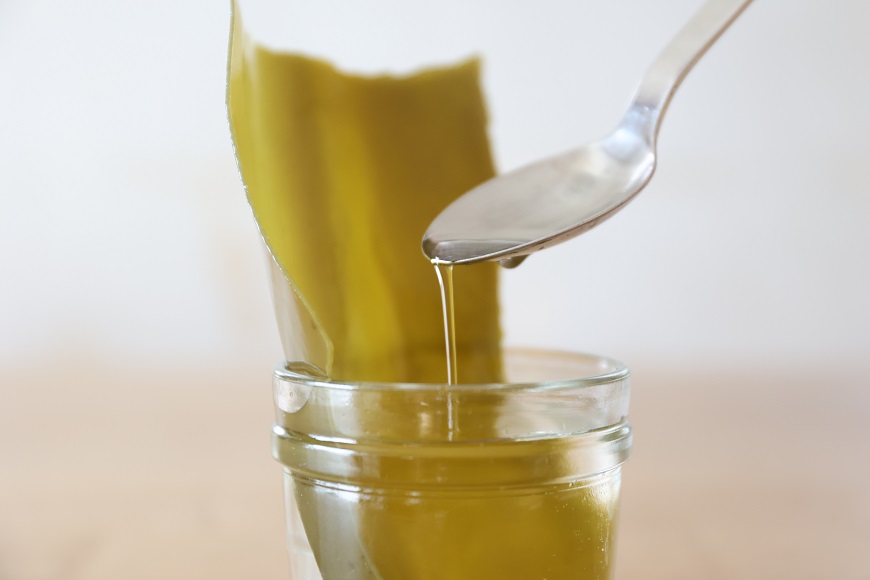
Strengthen Your Body With The Power Of Calcium
The amount of calcium contained in kombu kelp is 6 times that of milk.
Moreover, it is known that the calcium contained in seaweed is of higher quality than that of dairy products, is easily adapted to the human body, and has a high digestion and absorption rate.
Calcium is a nutrient that the body cannot produce, but using kombu kelp in your daily diet can prevent calcium deficiency.

Eliminate Iron Deficiency And Make Your Body Less Tired
Kombu kelp contains about three times as much iron as spinach and can be immediately incorporated as an ingredient to improve the basic strength of the body that tends to be easily tired.
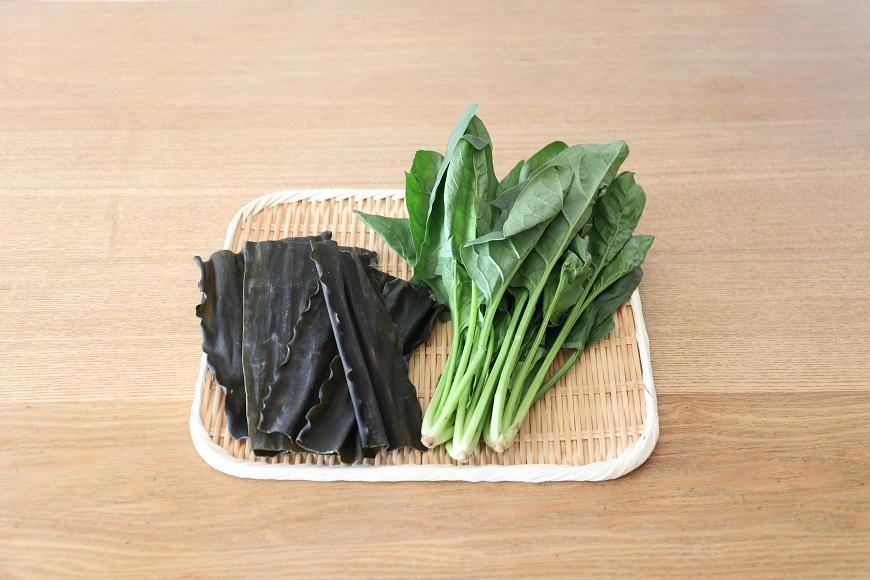
Iodine, An Essential Ingredient For Maintaining Good Health
Iodine is also related to the production of growth hormone, so it is an important nutrient for those who are worried about physical disorders and children who are in a period of physical and mental development. Iodine is one of the essential minerals, and taking it little by little every day helps maintain good health.
By eating kombu kelp together with soybean-based foods, the effect of saponin inside the soybeans that can help improve blood circulation will be strengthened. The recommended way to eat kombu kelp and soybeans is through traditional Japanese cooking like miso soup or yudofu.
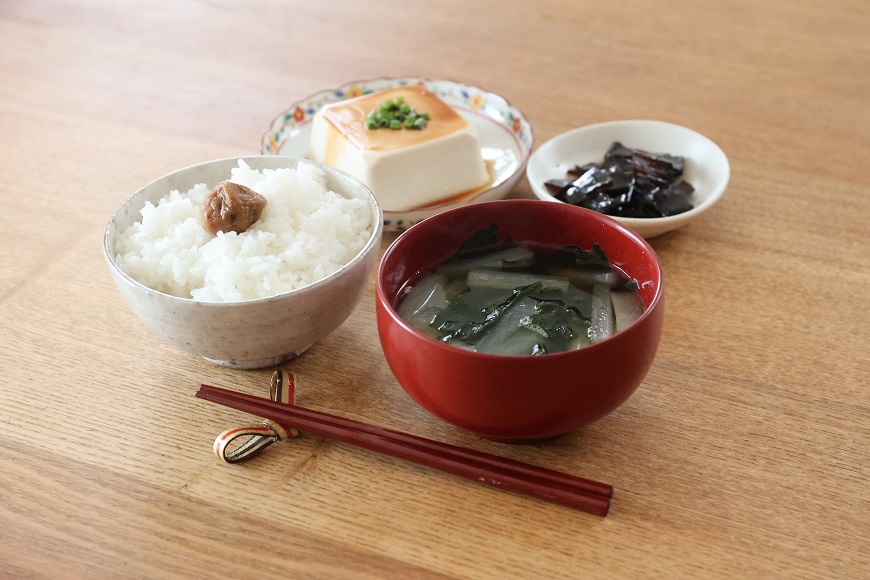
High-Quality Natural Hidaka Kombu Filled With Blessings Of The Pacific Ocean
The waves are rough along the coast of southern Hokkaido and the Hidaka region, therefore kombu kelp cannot be produced through aquaculture methods.
Hidaka kombu kelp is a precious sea blessing that can be harvested only on days when the weather and sea conditions are good during the fishing season, about 3 months from the beginning of July.
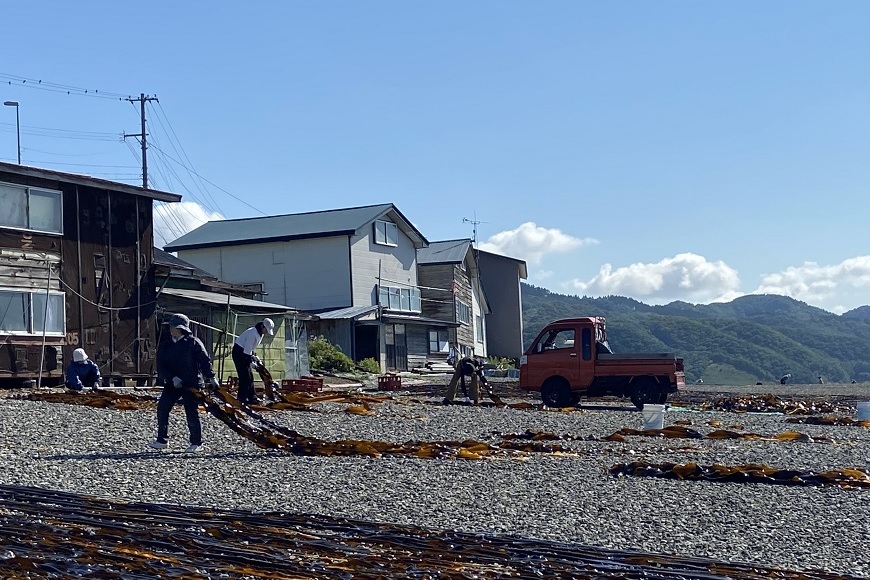
Hidaka kombu kelp, which has a unique flavor created by the traditional method of utilizing the nature of the Hidaka region, such as the gravel beach that promotes drying with the sunlight, moderate ventilation, and the beach breeze that slowly condenses umami, is truly a treasure of the beach.
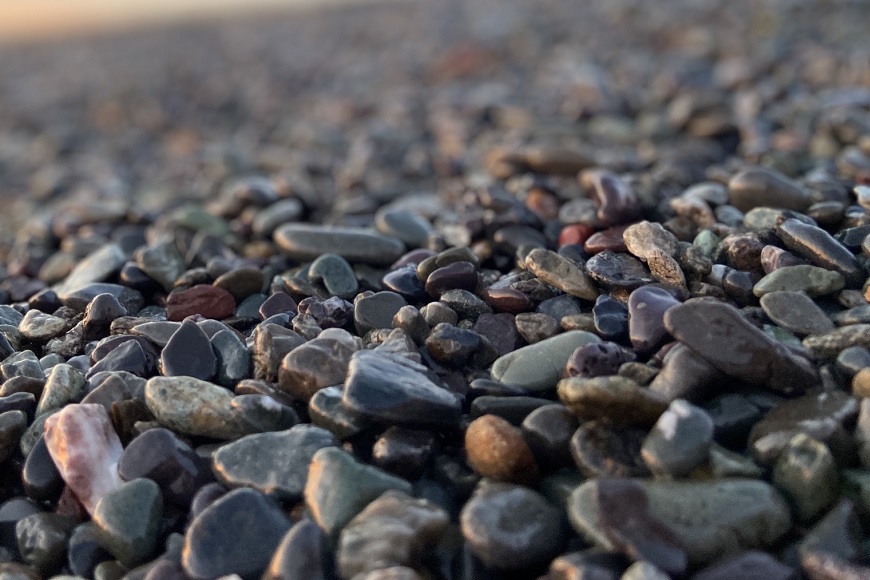
Kawashimaya's kombu kelp products are prepared carefully with the harvesting knowledge and experience of a Kombu kelp specialty shop in Hidaka, Hokkaido. Therefore the quality is guaranteed.
Check out our high quality kombu varieties
Kawashimaya's Kombu Products Development Story
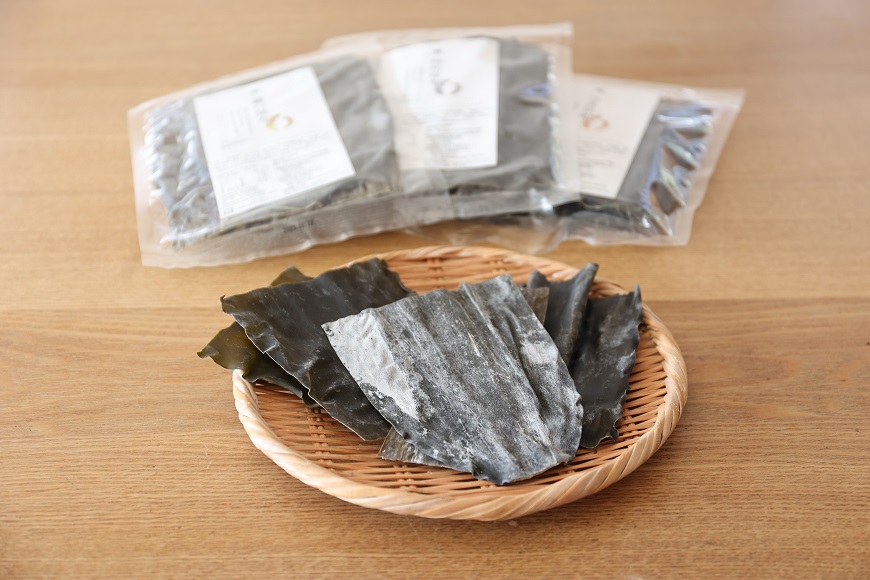
Kombu kelp is one of the traditional Japanese ingredients.
Did you know that different types of kombu kelp have completely different tastes and uses?
It's a food that Japanese people are familiar with, but when I looked it up, I was surprised at how deep the knowledge about kombu kelp was because it was full of things I didn't know.
In cooperation with Hokkaido producer Tamura Toshimitsu Shoten, we have prepared three types of kombu kelp while discussing many times which kelp will satisfy our customers. We only handle the highest quality kelp, grades 1 and 2. The taste, umami, and characteristics of each kombu kelp are completely different.
We hope that you will find your favorite kelp by using it according to your uses.
Frequently Asked Questions
- What are the characteristics of Hidaka kombu kelp?
- With a mellow flavor that is deep, kelp-like, and a refreshing aftertaste, you can get a soup stock that is well-suited to various uses.
When the kombu kelp is simmered, the softness, smoothness, and moderate texture are also wonderful. It is suitable not only as a kombu-based stock but also as an ingredient for simmered dishes.
- Is there a particularly recommended way to use Hidaka kombu kelp?
- It's not too strong and has a relatively mild flavor, so it's especially suitable for soup stock with dried bonito flakes. Taking advantage of its thickness that doesn't easily crumble, you can cook it as oden ingredients, kombu rolls, tsukudani, or other simmered dishes.
- I would like to drink kombu kelp water (kombu tea) every day for my health. Can I make it with Hidaka kombu kelp?
- Since the dietary fiber of Hidaka kelp is strong, it is difficult to dissolve in water. It’s impossible per se, but if you want nutrients from kombu water, we recommend using rishiri or rausu kombu instead.
- I heard that kombu kelp is good for your health, is that true?
- Kombu kelp is a strong alkaline food that is good for people with a modern lifestyle that tend to be unhealthy. It is also rich in calcium, minerals, dietary fiber, and vitamins.
- I heard that eating too much kombu kelp is dangerous, is that true?
- Dietary fiber and iodine contained in kelp have a strong effect, so if you take too much every day, it may cause stomach and thyroid disorders. But, there is no problem if you intake kombu kelp as a soup stock or cooking ingredients in a reasonable amount. One cup of kombu kelp water is the standard intake per day.
Product Detail Product Detail
| Ingredients | Hidaka Kelp |
|---|---|
| Quantity | 80g |
| Origin | Hidaka, Hokkaido, Japan |
| Storage Guide | Please store at room temperature. Avoid high temperatures and humidity. |
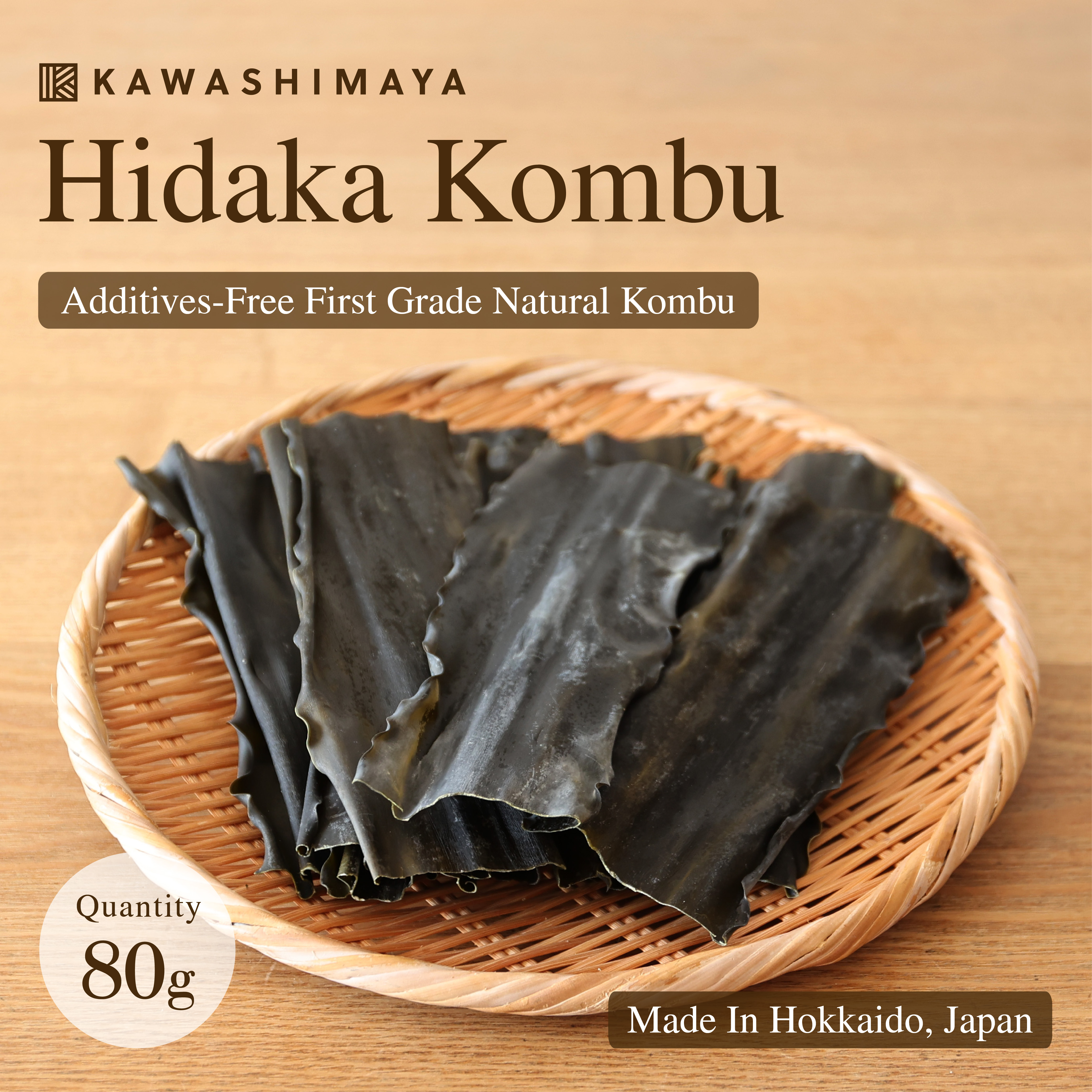
Why shop with KAWASHIMAYA?
- We sell only authentic and high-quality products
- 100% Made in Japan products are as listed
- Organic and non-GMO products are as listed
- All products are new and have long expiry date
- All products are handled directly from our warehouse in Tokyo, Japan
- Easy and secure payment options with CC or PayPal
- Safe and insured international shipping methods
- English and Japanese customer support by email
- Wholesale discount prices available for selected products
- Find insightful articles from KAWASHIMAYA Blog
- Get exclusive discounts for KAWASHIMAYA Newsletter subscribers
- Easy shop on KAWASHIMAYA Amazon USA

